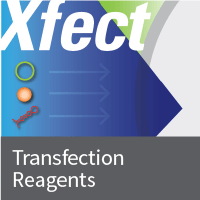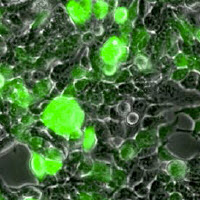FAQs about the Xfect Protein Transfection Reagent
Rapid, high-efficiency, low-toxicity protein transfection
- Transfect a large amount of active protein
- Virtually no cytotoxicity, unlike lipofection
- Very high efficiency, even in stem or hematopoietic cells
- Simple protocol—assay for your protein in just 2 hours
The Xfect Protein Transfection Reagent uses a cell-penetrating peptide developed at Takara Bio to bind and transport active proteins directly into a wide variety of mammalian cell types, including hard-to-transfect human suspension cell lines and mouse embryonic stem cells.
What is Xfect Protein Transfection Reagent and how does it work?
Xfect Protein Transfection Reagent is a modified peptide with a cell-penetrating activity whose amino acid composition enables it to interact with a protein cargo and transport this protein across the cell membrane barrier. Just incubate your protein of interest with Xfect in the supplied buffer for 30 min, then apply the mixture to your cells—2 hours later, you are ready to assay for protein activity.

Simple, rapid protein transfection with Xfect Protein Transfection Reagent. Xfect's cell-penetrating activity enables proteins to be transported across membranes of mammalian cells.
Why transfect purified proteins directly?
Protein transfection is extremely rapid compared to traditional gene expression studies using transfected DNA (1–2 hours compared to 18–48 hours) because it bypasses the cellular processes of transcription and translation. It also facilitates studies involving transient effects of proteins, and avoids potentially harmful, random DNA integration into the genome of the target cells. Xfect Protein Transfection Reagent makes it possible to deliver active proteins directly into cells for studies that involve transcriptional regulation, the cell cycle, apoptosis, oncogenesis, epigenetics, cell regeneration, and transdifferentiation.

Complete induction of an early apoptosis event within 2 hours via protein transfection of active caspase-3. Apoptosis is commonly detected using annexin V-FITC staining (see our ApoAlert Annexin V-FITC Apoptosis Kit, Cat. # 630109), which detects translocation of phosphatidylserine from the inner (cytoplasmic) leaflet of the plasma membrane to the outer (cell surface) leaflet soon after the induction of apoptosis. Annexin V-FITC staining is detected by the flow cytometric measurement of increased fluorescence intensity (Panels A and B). We transfected human recombinant caspase-3 using Xfect Protein Transfection Reagent and detected completion of apoptosis after just 2 hr, demonstrating that protein transfection using the Xfect protein reagent is both fast and delivers active protein (Panel B). In comparison, other methods for inducing apoptosis require 12 hr for completion of Annexin V staining (Martin et al. 1995).
Reference
Martin, S. J. et al. Early redistribution of plasma membrane phosphatidylserine is a general feature of apoptosis regardless of the initiating stimulus: inhibition by overexpression of Bcl-2 and Abl. J. Exp. Med. 182, 1545–56 (1995).
What are the advantages of Xfect Transfection Reagent compared to other protein delivery technologies?
The two technologies most frequently used for protein delivery are based on lipids and cell-penetrating peptides. Transfection with lipid-based reagents tends to result in high cytotoxicity, while peptide-based reagents transfect with low efficiency. Xfect Protein Transfection Reagent offers the best advantages of both (i.e., it retains low cytotoxicity and delivers more protein to a higher percentage of target cells). Moreover, this reagent can transfect cells that are growing at a higher density than competing products, which is important because assays are often performed within a few hours post-transfection, and the higher cell densities ensure sufficient material for downstream analysis.
Is the transfected protein active?
Yes, the protein is active. Assays that measure enzyme activity (such as caspase-3 or β-galactosidase) show that these proteins retain their activity after transfection with Xfect Protein Transfection Reagent, while fluorescent proteins retain their ability to fluoresce.

Xfect Protein Transfection Reagent delivers up to 8X more active β-galactosidase into HeLa cells than the leading competitor, Product C. Panel A. Xfect Protein Transfection Reagent or Product C was used to transfect Jurkat cells with various amount of β-galactosidase (β-gal) according to the manufacturers' recommended protocol. One hour post-transfection, the cells were assayed for β-gal activity using our Luminescent β-galactosidase Detection Kit II (Cat. # 631712). Xfect Protein Transfection Reagent displayed a far higher signal for β-gal than did Product C. Panel B. HeLa cells transfected with 4 μg of β-gal demonstrated higher efficiency and a higher amount of β-gal protein per cell when transfection was performed with Xfect Protein Transfection Reagent (middle panel) than with Product C (right-hand panel).
Does Xfect Protein Transfection Reagent deliver a high amount of protein?
Yes, Xfect Protein Transfection Reagent delivers far more protein per cell than the leading protein transfection reagent (Product C), a peptide-based reagent, in a broad range of cell types. This was demonstrated when we compared the amounts of β-galactosidase and fluorescent proteins delivered by each reagent. When we compared six different cell types, Xfect protein delivered 3- to 13-fold more protein than Product C. The biggest disadvantage of other protein delivery reagents is their limited ability to allow monitoring of a protein's biological effects (due to an inability to deliver sufficient active protein). Xfect protein delivers more protein per cell than other reagents, so it should expand the applications for protein delivery and/or allow you to use less protein for transfection.

Xfect Protein Transfection Reagent delivers more recombinant fluorescent proteins than Product C into a range of cell types. Xfect Protein Transfection Reagent and Product C were used to transfect a number of cell lines with purified recombinant fluorescent protein (either rAcGFP1 or rDsRed-Express). In all of the cell lines tested, a far greater MFI (mean fluorescence intensity) was detected via flow cytometry after transfection with Xfect Protein Transfection Reagent than after transfection with Product C.
Does Xfect Protein Transfection Reagent affect cell viability?
No, as demonstrated when we performed a WST-1 assay to compare the effects on HeLa cell proliferation of Xfect Protein Transfection Reagent and Product P (a popular lipid-based protein transfection technology). The Xfect reagent did not affect cell proliferation compared to untreated cells, while Product P decreased cell proliferation by more than 30%. When we used Xfect Protein Transfection Reagent to transfect DsRed-Express (a red fluorescent protein) into a commonly used mouse embryonic stem cell line and measured cell viability using trypan blue dye exclusion, the cells retained 100% viability.

Xfect Protein Transfection Reagent provides much higher cell viability than Product P when transfecting HeLa cells. HeLa cells were seeded in a 96-well plate (3 x 104 cells per well) one day prior to transfection. The cells were transfected with 0.25 μg of β-galactosidase using Product P or Xfect Protein Transfection Reagent for 4 hours. A WST-1 proliferation assay was performed to assess cytotoxicity in the transfected samples relative to untreated HeLa cells.

Cytotoxicity is undetectable in mouse embryonic stem cells. 1, 2.5, or 5 μg of a recombinant red fluorescent protein (rDsRed-Express) was transfected with high efficiency into E14TG2a mES cells. Relative cell viability was measured by a dye-exclusion assay, which showed that the cells retain 100% viability compared to an untransfected cells control (cells only) and a negative (no reagent) control (5 μg of rDsRed-Express added to cells without any transfection reagent).
What is the transfection efficiency of Xfect Protein Transfection Reagent?
The transfection efficiency of Xfect Protein Transfection Reagent can vary depending on the cell type and protein delivered. However, in all cell lines tested, Xfect protein outperforms Product C. When we transfected AcGFP1 (green fluorescent protein) into several different cell types using Xfect protein and measured transfection efficiency using flow cytometry, more than 90% of the cells were transfected in four out of the eight cell types that we tested, and seven of the eight showed more than 80% transfection efficiency (Panel A). When immunofluorescence microscopy was used to compare the efficiency of AcGFP1 transfection into HeLa cells using Xfect protein and Product C (a leading competitor), a high level of transfection was observed only for the cells treated with Xfect Protein Transfection Reagent (Panel B).

Protein transfection efficiencies across different cell lines: Xfect Protein Transfection Reagent vs. the leading competitor, Product C. Panel A. Xfect Protein Transfection Reagent yields higher transfection efficiencies than Product C across a broad range of mammalian cells, including a number of rodent and human cell lines, hard-to-transfect human suspension cells, and mouse embryonic stem cells. The cells were transfected with 4 μg of recombinant fluorescent protein (either rAcGFP1 or rDsRed-Express) using Xfect Protein Transfection Reagent or Product C according to the manufacturers' recommended protocol. Transfection efficiency was assessed by flow cytometry one-hour post-transfection. Panel B. HeLa transfected with 5 μg of rAcGFP1 using Product C or Xfect Protein Transfection Reagent.
Will Xfect Protein Transfection Reagent work for all cell types, including cell types that cannot be easily transfected with DNA?
Target cell choices are not limited. We have successfully transfected a variety of mammalian cell types (human and rodent) with high efficiency, including hard-to-transfect human suspension cell lines (Jurkat, HL-60), which were transfected with close to 100% efficiency. Mouse ES cells (E14TG2A) were transfected at an amazing 87% efficiency when using Xfect Protein Transfection Reagent despite the fact that they cannot be transfected using Product C from a leading competitor (see "What is the transfection efficiency of Xfect Protein Transfection Reagent?" above for more details)

Xfect Transfection Reagent yields extremely high transfection efficiencies even in difficult-to-transfect human suspension cell lines such as HL-60 or Jurkat.
Does Xfect Protein Transfection Reagent work for all proteins?
Since every protein has unique physicochemical characteristics, it is unlikely that any protein transfection reagent will transfect all proteins. However, Xfect Protein Transfection Reagent has been used successfully to transfect numerous proteins with a wide range of molecular weights and physicochemical characteristics. Proteins we have successfully transfected include ß-galactosidase, fluorescent proteins such as rAcGFP1 and rDsRed-Express, anti-alpha tubulin antibody, caspase-3, and R-phycoerythrin. R-phycoerythrin is a very large protein (~240 kDa). Optimizing the ratio of reagent to protein will allow you to determine the appropriate conditions for delivery of your protein of interest.
Related links
Takara Bio USA, Inc.
United States/Canada: +1.800.662.2566 • Asia Pacific: +1.650.919.7300 • Europe: +33.(0)1.3904.6880 • Japan: +81.(0)77.565.6999
FOR RESEARCH USE ONLY. NOT FOR USE IN DIAGNOSTIC PROCEDURES. © 2025 Takara Bio Inc. All Rights Reserved. All trademarks are the property of Takara Bio Inc. or its affiliate(s) in the U.S. and/or other countries or their respective owners. Certain trademarks may not be registered in all jurisdictions. Additional product, intellectual property, and restricted use information is available at takarabio.com.





